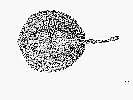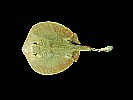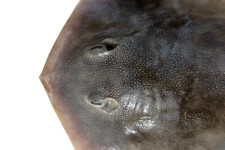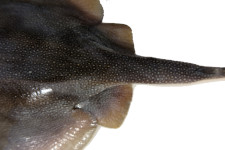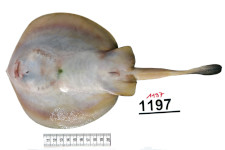Urobatis halleri
(Cooper, 1863)
Haller's round ray
Classification: Elasmobranchii Myliobatiformes Urotrygonidae
Reference of the original description
On new genera and species of Californian fishes. N° II. Proceedings of the California Academy of Sciences, (Series 1), 3(6), 93–97
On new genera and species of Californian fishes. N° II. Proceedings of the California Academy of Sciences, (Series 1), 3(6), 93–97
Image of the original description
.jpg)
Urobatis halleri (Cooper, 1863)
.jpg)
Urobatis halleri (Cooper, 1863)
Synonyms / new combinations and misspellings
Urobatis nebulosus, Urobatis umbrifer, Urolophus halleri, Urolophus nebulosus, Urolophus umbrifer
Urobatis nebulosus, Urobatis umbrifer, Urolophus halleri, Urolophus nebulosus, Urolophus umbrifer
Types
Urobatis halleri
Urolophus nebulosus
Holotype: USNM: 7356
Urolophus umbrifer
Holotype: SU: 2948 Paratype: BMNH: 1895.5.27.338 (ex SU 2914) SU: 2914 ZMB: 14039 (ex SU 2914)
Urobatis halleri
Urolophus nebulosus
Holotype: USNM: 7356
Urolophus umbrifer
Holotype: SU: 2948 Paratype: BMNH: 1895.5.27.338 (ex SU 2914) SU: 2914 ZMB: 14039 (ex SU 2914)
Description :
Citation: Urobatis halleri (Cooper, 1863): In: Database of modern sharks, rays and chimaeras, www.shark-references.com, World Wide Web electronic publication, Version 01/2026
Please send your images of "Urobatis halleri" to info@shark-references.com
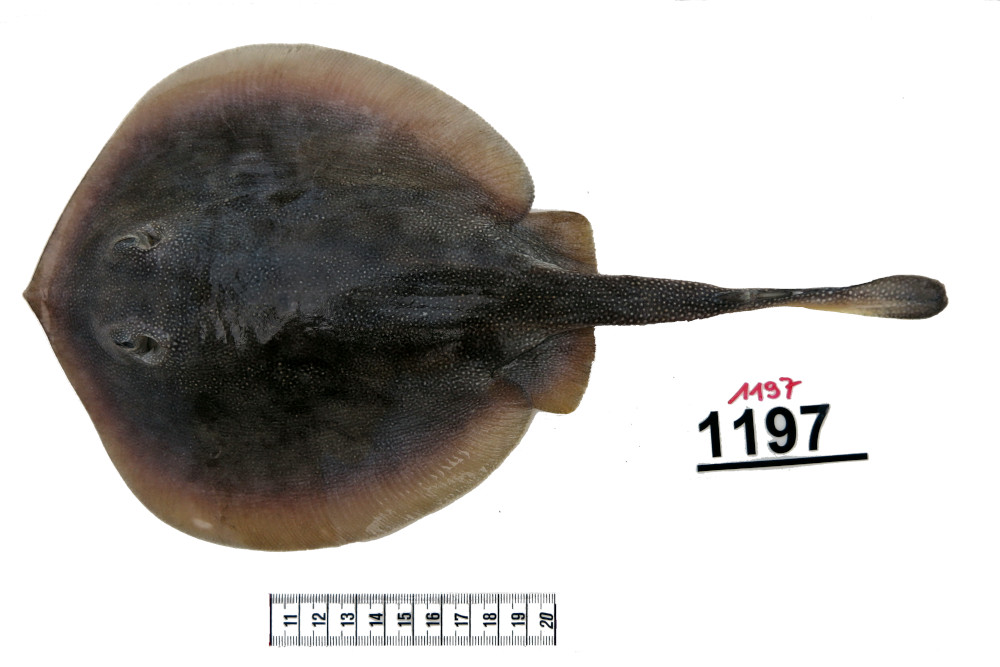
Urobatis halleri (Cooper, 1863), ERB 1197, female, 18, 0 DW, 32, 4 TL, Central Eastern Pacific © Frederik H. Mollen (Elasmobranch Research Belgium)

Urobatis halleri (Cooper, 1863), ERB 1197, female, 18, 0 DW, 32, 4 TL, Central Eastern Pacific © Frederik H. Mollen (Elasmobranch Research Belgium)
Common names
 Peitschenrochen,
Peitschenrochen,  Stechrochen,
Stechrochen,  Pastinaca,
Pastinaca,  Raya,
Raya,  Raya de espina,
Raya de espina,  Raya redonda común,
Raya redonda común,  Raya redonda de Haller,
Raya redonda de Haller,  Raya redonda de aguijón,
Raya redonda de aguijón,  Raya sicodélica,
Raya sicodélica,  Raie ronde de Haller,
Raie ronde de Haller,  Haller"s round ray,
Haller"s round ray,  Round stingray,
Round stingray,  Pastinaca,
Pastinaca,  Trigono
Trigono
 Peitschenrochen,
Peitschenrochen,  Stechrochen,
Stechrochen,  Pastinaca,
Pastinaca,  Raya,
Raya,  Raya de espina,
Raya de espina,  Raya redonda común,
Raya redonda común,  Raya redonda de Haller,
Raya redonda de Haller,  Raya redonda de aguijón,
Raya redonda de aguijón,  Raya sicodélica,
Raya sicodélica,  Raie ronde de Haller,
Raie ronde de Haller,  Haller"s round ray,
Haller"s round ray,  Round stingray,
Round stingray,  Pastinaca,
Pastinaca,  Trigono
Trigono
Short Description
Diet: central Mexican Pacific (data base: 175 stomachs were analyzed): The diet of this species was mainly composed of microcrustaceans, such as caridean shrimp and brachyuran and stomatopod larvae (>80% IRI), and differed significantly between seasons (table 2). During period T1 (the warm period, extends from July to December) three main categories were identified: Processidae, stomatopod larvae, and brachyuran larvae (>96% IRI). During period T2 (the cold period extends from January to June) the diet consisted primarily of amphipods, carideans (Ogyriididae and Processidae), Portunus asper, and penaeids (>93% IRI). [13684]
Diet: central Mexican Pacific (data base: 175 stomachs were analyzed): The diet of this species was mainly composed of microcrustaceans, such as caridean shrimp and brachyuran and stomatopod larvae (>80% IRI), and differed significantly between seasons (table 2). During period T1 (the warm period, extends from July to December) three main categories were identified: Processidae, stomatopod larvae, and brachyuran larvae (>96% IRI). During period T2 (the cold period extends from January to June) the diet consisted primarily of amphipods, carideans (Ogyriididae and Processidae), Portunus asper, and penaeids (>93% IRI). [13684]
Distribution
Eastern Pacific: Eureka in northern California, USA to Panama.
Eastern Pacific: Eureka in northern California, USA to Panama.
Human uses
fisheries: minor commercial; gamefish: yes; aquarium: public aquariums; price category: medium; price reliability: unreliable: based on ex-vessel price for species in this order
fisheries: minor commercial; gamefish: yes; aquarium: public aquariums; price category: medium; price reliability: unreliable: based on ex-vessel price for species in this order
Biology
Male grasps disc margin of female, flips under her, and inserts a clasper. Mating lasts about 5 minutes. Occurs on sand or mud bottom off beaches and in bays and sloughs [17050]. Densities of this species were significantly higher at warmer effluent water near the surfzone at Seal Beach, California than to cooler, ambient water further offshore (Ref. 54651). Mobile invertebrate feeder (Ref. 57615). Feeds on benthic invertebrates and small fishes.
Male grasps disc margin of female, flips under her, and inserts a clasper. Mating lasts about 5 minutes. Occurs on sand or mud bottom off beaches and in bays and sloughs [17050]. Densities of this species were significantly higher at warmer effluent water near the surfzone at Seal Beach, California than to cooler, ambient water further offshore (Ref. 54651). Mobile invertebrate feeder (Ref. 57615). Feeds on benthic invertebrates and small fishes.
Size / Weight / Age
58.0 cm TL (male/unsexed; (Ref. 40637)); max. published weight: 1,360 g (Ref. 4699)
58.0 cm TL (male/unsexed; (Ref. 40637)); max. published weight: 1,360 g (Ref. 4699)
Remarks
shark-references Species-ID=7396;
shark-references Species-ID=7396;
Parasites (arranged by Jürgen Pollerspöck)
Conoidasida
Myxosporea
Monogenea
Cestoda
Trematoda
Copepoda
Hirudinea
Conoidasida
- Eimeria chollaensis Upton, Gardner & Duszynski, 1988 [12584] [32027]
- Eimeria halleri Upton, Bristol, Gardner & Duszynski, 1986 [32027]
Myxosporea
- Chloromyxum ovatum Jameson, 1929 [23380]
Monogenea
- Calicotyle urobati Bullard & Overstreet, 2000 [7567] [23771] [26032]
- Listrocephalos guberleti (Caballero & Bravo-Hollis, 1962) [7595] [23771] [26032]
Cestoda
- Acanthobothrium crassicolle Wedl, 1855 [16448]
- Acanthobothrium dujardinii Van Beneden, 1849 [16448]
- Acanthobothrium olseni Dailey & Mudry, 1968 [15084] [23771] [28741]
- Acanthobothrium parviuncinatum Young, 1954 [16130] [16175] [16448] [16929] [15084] [23771] [28741]
- Acanthobothrium sp. [15084] [23771]
- Anthobothrium oligorchidum Young, 1954 [16130]
- Anthocephalum duszynskii Ruhnke, 1994 [16388] [23771]
- Caulobothrium multorchidum (Young, 1954) Appy & Dailey, 1977 [16130] [16246]
- Dollfusiella cortezensis (Friggens & Duszynski, 2005) [16214] [20557] [23434]
- Dollfusiella cotezensis [23771]
- Dollfusiella schmidti (Heinz & Dailey, 1974) Beveridge, Neifar & Euzet, 2004 [16323] [16112]
- Dollfusiella sp. [16112]
- Eutetrarhynchus sp. [15084]
- Grillotia (Christianella) sp. [16112]
- Halysioncum hoffmanorum (Tyler, 2001) [16203] [16430] [19536] [23771]
- Hispidorhynchus paulinae (Toth, Campbell & Schmidt, 1992) Schaeffner & Beveridge, 2012 [16428] [16112] [15084] [23771]
- Mecistobothrium myliobati Heinz & Dailey, 1974 [16323] [16112] [15084] [23771]
- Onchobothrium sp. [23771]
- Parachristianella trygonis Dollfus, 1946 [16112]
- Phyllobothrium hallericola Church & Schmidt, 1990 [16198] [23771]
- Phyllobothrium sp. [15084] [23771]
- Prochristianella minima Heinz & Dailey, 1974 [16323] [16112] [15084] [23771]
- Prochristianella multidum Friggens & Duszynski, 2005 [16214] [23771]
- Prochristianella sp. [16112] [15084]
- Rhinebothrium chollaense Friggens & Duszynski, 2005 [16214] [23771]
- Rhinebothrium gravidum Friggens & Duszynski, 2005 [16214] [23771]
- Rhinebothrium sp. [15084]
- Rhinebothrium urobatidium (Young, 1955) Appy & Dailey, 1977 [16466] [16246] [15084] [23771] [27848]
- Ruptobothrium ditesticulum (Appy & Dailey, 1977) Coleman, Beveridge & Campbell, 2019 [16246] [16923]
- Scalithrium bilobatum (Young, 1955) Ball, Neifar & Euzet, 2003 [16466] [16246]
Trematoda
- Anaporrhutum euzeti Curran, Blend & Overstreet, 2003 [23771]
Copepoda
Hirudinea
- Branchellion lobata Moore, 1952 [33486]








